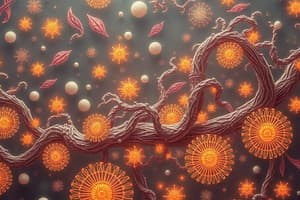Podcast
Questions and Answers
¿Cuál de los siguientes factores no afecta la velocidad de difusión de una sustancia a través de una membrana?
¿Cuál de los siguientes factores no afecta la velocidad de difusión de una sustancia a través de una membrana?
- El gradiente de concentración de la sustancia.
- El tamaño de las moléculas que se difunden.
- La carga eléctrica de la membrana. (correct)
- La temperatura del sistema.
¿Qué tipo de molécula puede cruzar una membrana por difusión simple?
¿Qué tipo de molécula puede cruzar una membrana por difusión simple?
- Moléculas grandes y polares como la glucosa.
- Iones como el $Na^+$ o $K^+$.
- Aminoácidos cargados.
- Moléculas pequeñas y no polares como el $O_2$ o $CO_2$. (correct)
¿Cuál de los siguientes procesos requiere una proteína transportadora para facilitar el movimiento de una sustancia a través de la membrana celular?
¿Cuál de los siguientes procesos requiere una proteína transportadora para facilitar el movimiento de una sustancia a través de la membrana celular?
- Transporte activo primario.
- Difusión facilitada. (correct)
- Ósmosis.
- Difusión simple.
Si una célula se coloca en una solución hipertónica, ¿qué ocurrirá?
Si una célula se coloca en una solución hipertónica, ¿qué ocurrirá?
¿Cuál es la principal diferencia entre presión osmótica y presión oncótica?
¿Cuál es la principal diferencia entre presión osmótica y presión oncótica?
¿Qué característica define a una membrana semipermeable?
¿Qué característica define a una membrana semipermeable?
¿Cómo se define la osmolaridad de una solución?
¿Cómo se define la osmolaridad de una solución?
Si una solución tiene una osmolaridad de 300 mOsm/L, ¿cómo se clasificaría en relación con la osmolaridad normal de la sangre (290-300 mOsm/L)?
Si una solución tiene una osmolaridad de 300 mOsm/L, ¿cómo se clasificaría en relación con la osmolaridad normal de la sangre (290-300 mOsm/L)?
¿Cuál de las siguientes soluciones intravenosas se clasifica como isotónica?
¿Cuál de las siguientes soluciones intravenosas se clasifica como isotónica?
¿Cuál de los siguientes es un objetivo específico al estudiar la presión osmótica y la osmolaridad en medicina?
¿Cuál de los siguientes es un objetivo específico al estudiar la presión osmótica y la osmolaridad en medicina?
¿Qué representa el factor de Van't Hoff en el contexto de la osmolaridad?
¿Qué representa el factor de Van't Hoff en el contexto de la osmolaridad?
Si se colocan glóbulos rojos en una solución de NaCl al 0.45% (m/v), ¿qué les ocurrirá y cómo se clasificaría esta solución?
Si se colocan glóbulos rojos en una solución de NaCl al 0.45% (m/v), ¿qué les ocurrirá y cómo se clasificaría esta solución?
¿Qué significa que una solución sea 'isotónica'?
¿Qué significa que una solución sea 'isotónica'?
De los siguientes compartimentos de agua corporal, ¿cuál representa el mayor porcentaje del agua corporal total (ACT)?
De los siguientes compartimentos de agua corporal, ¿cuál representa el mayor porcentaje del agua corporal total (ACT)?
¿Cuál es la principal fuerza que impulsa el movimiento del agua en la ósmosis?
¿Cuál es la principal fuerza que impulsa el movimiento del agua en la ósmosis?
La sangre tiene una osmolaridad entre 290-300 mOsm/L. Si una célula se coloca en una solución con una osmolaridad de 200 mOsm/L, ¿cómo se esperaría que se moviera el agua?
La sangre tiene una osmolaridad entre 290-300 mOsm/L. Si una célula se coloca en una solución con una osmolaridad de 200 mOsm/L, ¿cómo se esperaría que se moviera el agua?
¿Cuál de las siguientes opciones describe mejor el proceso de difusión?
¿Cuál de las siguientes opciones describe mejor el proceso de difusión?
Si se tiene una solución de glucosa al 5% (m/v), ¿cómo se clasificaría en términos de tonicidad en relación con el plasma sanguíneo?
Si se tiene una solución de glucosa al 5% (m/v), ¿cómo se clasificaría en términos de tonicidad en relación con el plasma sanguíneo?
¿Cuál es la función principal del transporte activo primario?
¿Cuál es la función principal del transporte activo primario?
Si una solución tiene una alta presión osmótica, ¿qué se puede inferir sobre su concentración de solutos?
Si una solución tiene una alta presión osmótica, ¿qué se puede inferir sobre su concentración de solutos?
¿Qué sucede con una célula en una solución hipotónica?
¿Qué sucede con una célula en una solución hipotónica?
¿Qué efecto tiene el aumento de la temperatura en la velocidad de difusión?
¿Qué efecto tiene el aumento de la temperatura en la velocidad de difusión?
¿Cuál de los siguientes es un ejemplo de transporte activo primario que mantiene el potencial de membrana en las células nerviosas?
¿Cuál de los siguientes es un ejemplo de transporte activo primario que mantiene el potencial de membrana en las células nerviosas?
¿Cómo afectaría un aumento en la concentración de proteínas plasmáticas a la presión oncótica en los capilares sanguíneos?
¿Cómo afectaría un aumento en la concentración de proteínas plasmáticas a la presión oncótica en los capilares sanguíneos?
¿Cuál es la diferencia entre osmolaridad y osmolalidad?
¿Cuál es la diferencia entre osmolaridad y osmolalidad?
¿Qué factor determina si una sustancia puede cruzar una membrana celular por difusión simple?
¿Qué factor determina si una sustancia puede cruzar una membrana celular por difusión simple?
¿Cómo afecta una disminución en la concentración de albúmina en el plasma sanguíneo al equilibrio de fluidos en los capilares?
¿Cómo afecta una disminución en la concentración de albúmina en el plasma sanguíneo al equilibrio de fluidos en los capilares?
¿Cuál es la relación entre la presión osmótica y la concentración de solutos en una solución?
¿Cuál es la relación entre la presión osmótica y la concentración de solutos en una solución?
¿Qué ocurre si una célula se coloca en una solución isotónica?
¿Qué ocurre si una célula se coloca en una solución isotónica?
¿Cuál es la importancia de mantener la osmolaridad de la sangre dentro de un rango estrecho?
¿Cuál es la importancia de mantener la osmolaridad de la sangre dentro de un rango estrecho?
¿Qué función cumplen las acuaporinas en el transporte celular?
¿Qué función cumplen las acuaporinas en el transporte celular?
En la ecuación de la presión osmótica ($\pi = gC\sigma RT$), ¿qué representa el factor $\sigma$?
En la ecuación de la presión osmótica ($\pi = gC\sigma RT$), ¿qué representa el factor $\sigma$?
Flashcards
¿Qué es una membrana semipermeable?
¿Qué es una membrana semipermeable?
Es un material que permite el paso de moléculas del disolvente, pero impide el paso de moléculas de soluto.
¿Qué es la difusión?
¿Qué es la difusión?
Proceso por el cual las moléculas se desplazan de una zona de alta concentración a una de baja concentración.
¿Qué es la ósmosis?
¿Qué es la ósmosis?
Paso selectivo de moléculas del disolvente a través de una membrana porosa, desde una disolución diluida hacia una más concentrada.
¿Qué es la osmolaridad?
¿Qué es la osmolaridad?
Signup and view all the flashcards
¿Qué es la osmolalidad?
¿Qué es la osmolalidad?
Signup and view all the flashcards
¿Qué es la presión osmótica?
¿Qué es la presión osmótica?
Signup and view all the flashcards
¿Qué son disoluciones isotónicas?
¿Qué son disoluciones isotónicas?
Signup and view all the flashcards
¿Qué son disoluciones hipertónicas?
¿Qué son disoluciones hipertónicas?
Signup and view all the flashcards
¿Qué son cristaloides?
¿Qué son cristaloides?
Signup and view all the flashcards
¿Presión Osmótica?
¿Presión Osmótica?
Signup and view all the flashcards
Study Notes
- The presentation discusses osmotic pressure and osmolarity
- Jackeline Burgos is credited as the presenter
Specific Objectives
- Understand diffusion, semipermeable membranes, osmosis, and osmotic pressure
- Relate these concepts to cellular exchange processes in the human body
- Understand how different solutes interact with the cell membrane based on molecule polarity
- Understand and apply the ionization process of electrolytes in aqueous solutions
- Calculate and convert between moles and osmoles
- Use Van't Hoff factor correctly
- Calculate osmotic parameters: osmotic pressure, osmolarity, and osmolality
- Distinguish between solution types based on osmotic pressure and understand their effects on cells
Body Fluids
- Total Body Water (TBW) is 60%
- Solids constitute 40% of the body composition
- Intracellular fluid represents 60% of TBW
- Extracellular fluid represents 40% of TBW
- Plasma is a type of extracellular fluid
- Interstitial fluid is another type of extracellular fluid
- Transcellular compartment is also present in the body
Semipermeable Membrane
- A semipermeable membrane allows solvent molecules to pass through
- A semipermeable membrane prevents solute molecules from passing through
- Pore size in the membrane influences permeability
- Solvent solubility affects permeability
- Membrane charge affects permeability
Diffusion
- Diffusion is the process by which molecules/ions move from an area of higher to lower concentration
- Diffusion speed factors include molecule size and temperature
- Diffusion happens because of the random thermal motion of solutes
Diffusion Example
- Oxygen moves from the alveoli into the blood
- Carbon dioxide moves from the blood into the alveoli
Intracellular and Extracellular fluid composition
- Sodium is higher in extracellular fluid (140 mEq/l)
- Potassium is higher in intracellular fluid (120 mEq/l)
- Chloride is higher in extracellular fluid (105 mEq/l)
- Bicarbonate is higher in extracellular fluid (24 mEq/l)
- Proteins are higher in intracellular fluid (60)
- Phosphates are higher in intracellular fluid (140)
- Osmolarity of both intracellular and extracellular fluid is about 290 mOsm/l
Electrolyte concentrations
- Sodium level is 138 mEq/L in plasma
- Potassium level is 5 mEq/L in plasma
- Magnesium level is 3 mEq/L in plasma
- Calcium level is 4 mEq/L in plasma
- Chloride level is 110 mEq/L in plasma
- Bicarbonate level is 30 mEq/L in plasma
- Phosphate is 4 mEq/L in plasma
- Proteins are 6 mEq/L in plasma
Cell Exchange with External Environment
- Passive transport includes simple and facilitated diffusion
- Simple diffusion involves lipophilic substances like O2, N2, CO2, and vitamin A
- Facilitated diffusion requires channels or transport proteins for hydrophilic substances like H2O, glucose, and electrolytes
Cell Exchange with External Environment - Primary Active Transport
- Primary active transport uses ATP
- Examples include sodium-potassium pump
Osmosis
- Osmosis is the selective passage of solvent molecules (usually water) through a porous membrane
- Osmosis goes from a dilute solution to a more concentrated one
- Osmosis occurs through a semipermeable membrane due to differences in solute concentration
- Aquaporins are involved in water transport
Osmolarity
- Osmolarity represents the concentration of osmotically active particles
- Osmolarity = Osmoles/L
- Osmotically active particles are solutes that promote solvent movement across a semipermeable or cell membrane
- The defining equation is: Osmolarity = g x C, where g = number of particles per mole in solution and C = concentration
Van't Hoff factor
- NaCl dissociates into Na+ and Cl- (i=2)
- One mole of NaCl yields 2 osmotically active particles
- Na2SO4 dissociates into 2Na+ and SO4^2- (i=3)
- One mole of Na2SO4 yields 3 osmotically active particles
- Sucrose is a nonelectrolyte (i=1)
Osmolarity Example Calculation
- 1.4 g of NaCl is dissolved in 100 ml of solution (MW of NaCl = 58.44 g/mol)
- Molarity = 0.2395 mol/L, and i=2
- Osmolarity = g x C = (2 osmoles NaCl / mol NaCl) x 0.2395 mol NaCl / L = 0.479 osmoles NaCl / L = 479 milliosmoles NaCl / L
Osmolality
- Osmolality is the number of osmoles per kilogram of solvent
- Osmolality = g x C
- C = 0.02395 moles of NaCl / 0.1 kg of solvent = 0.2395 moles of NaCl / kg of solvent
- Osmolality calculation for 1.4g NaCl in 100mL water is approximately 0.479 osmoles of NaCl per kg of H2O, assuming 100mL equals 100g and density is 1
Osmotic Pressure
- Osmotic pressure is the pressure generated by a difference in the concentration of dissolved substances separated by a semipermeable membrane
- The defining equation is π = g x C x σ x R x T
- π = Osmotic Pressure (atm or mmHg)
- g = # of particles per mole in solution (Osm/mol)
- C = Concentration (mol/l)
- σ = Reflection coefficient (ranges from 0 to 1)
- R = Gas constant (0.0821 L atm / mol K) or 62.364 mmHg L / mol K
- T = Absolute temperature (K)
- Can also use the formula π = iMRT
Osmotic Pressure Calculation Example
- 1.4 g NaCl dissolved in 100 ml solution
- π = g x C x σ x R x T
- C (Molarity) = 0.2395 mol NaCl / L and g = 2
- The result of the variables and equation becomes Π = 3.513 atm
Tonicity
- A 15% glucose solution and a 7% glucose solution are separated by a semipermeable membrane
- The 15% glucose solution has a higher osmotic pressure
Solution Classifications
- Isotonic solutions: Two solutions having the same concentration and osmotic pressure
- Hypertonic solutions: Higher concentration and therefore different osmotic pressure
- Crystalloids solutions are electrolytic and/or sugar solutions. They maintain hydroelectrolytic balance and can be hypo, isotonic, or hypertonic
- Isotonic/Isoosmotic: 0.9% physiological solution, Ringer's Solution, Ringer lactate solution, 5% Glucosated(Dextrose) Solution, glucosalina solution
- Hypotonic: 0.45 hyposaline
- Hypertonic: 10%, 20%, and 40% glucosated solutions, 7.5% saline solution
Electrolyte solutions
- The osmolarity of blood is 290-300 mOsm/L
- Hypotonic solutions are <290 mOsm/L
- Isotonic solutions are 290-300 mOsm/L
- Hypertonic solutions are >300 mOsm/L
Pressure determining water flow in a capillary
- Hydrostatic pressure: The pressure exerted by the blood within blood vessels
- Osmotic pressure: Force generated by the difference in concentration in osmotically active particles
- Oncotic pressure: Force generated by the difference in concentration of colloidal particles in the blood plasma
Studying That Suits You
Use AI to generate personalized quizzes and flashcards to suit your learning preferences.




